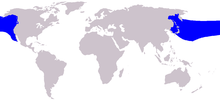| Berardius Temporal range: Middle Miocene to present,
| |
|---|---|

| |
| Photo of Arnoux's beaked whale | |

| |
| Illustration of Baird's beaked whale | |
| Scientific classification | |
| Domain: | Eukaryota |
| Kingdom: | Animalia |
| Phylum: | Chordata |
| Class: | Mammalia |
| Order: | Artiodactyla |
| Infraorder: | Cetacea |
| Family: | Ziphiidae |
| Subfamily: | Berardiinae |
| Genus: | Berardius Duvernoy, 1851 |
| Type species | |
| Berardius arnuxii [1] Duvernoy, 1851
| |
| Species | |
| |

| |
| Arnoux's beaked whale range | |

| |
| Baird's beaked whale range | |
The four-toothed whales or giant beaked whales are beaked whales in the genus Berardius. They include Arnoux's beaked whale (Berardius arnuxii) in cold Southern Hemispheric waters, and Baird's beaked whale (Berardius bairdii) in the cold temperate waters of the North Pacific. A third species, Sato's beaked whale (Berardius minimus), was distinguished from B. bairdii in the 2010s.[2]
Arnoux's and Baird's beaked whales are so similar that researchers have debated whether or not they are simply two populations of the same species. However, genetic evidence and their wide geographical separation has led them to be classified as separate.[3] Lifespan estimates, based on earwax plug samples, indicate male whales can live up to 85 years, while females can have a lifespan of 54 years.[4][5] It is estimated that the length at birth is ~4 metres (13 ft). Growing up to ~10 metres (33 ft), these are the largest whales belonging to the family Ziphiidae.[6] Sato's beaked whale is much smaller, with adult males having a length of ~7 metres (23 ft).[7]
While Berardius arnuxii and Berardius bairdii are considered least concern by the IUCN,[8][9] Berardius minimus is labeled as near threatened as of 2023[update].[10]
This article currently largely treats four-toothed whales as monospecific, due to a lack of species-specific information.
- ^ Wilson, D. E.; Reeder, D. M., eds. (2005). Mammal Species of the World: A Taxonomic and Geographic Reference (3rd ed.). Johns Hopkins University Press. ISBN 978-0-8018-8221-0. OCLC 62265494.
- ^ Yamada, Tadasu K.; Kitamura, Shino; Abe, Syuiti; Tajima, Yuko; Matsuda, Ayaka; Mead, James G.; Matsuishi, Takashi F. (30 August 2019). "Description of a new species of beaked whale (Berardius) found in the North Pacific". Scientific Reports. 9 (1): 12723. Bibcode:2019NatSR...912723Y. doi:10.1038/s41598-019-46703-w. PMC 6717206. PMID 31471538.
- ^ Cite error: The named reference
Daleboutwas invoked but never defined (see the help page). - ^ Fisheries, NOAA (17 May 2021). "Baird's Beaked Whale | NOAA Fisheries". NOAA. Retrieved 22 May 2021.
- ^ "Berardius bairdii". The Moirai - Aging Research. 19 October 2016. Archived from the original on 21 November 2016. Retrieved 20 November 2016.
- ^ "FAO Fisheries & Aquaculture - Aquatic species". www.fao.org. Retrieved 22 May 2021.
- ^ "Sato's beaked whale". Whale & Dolphin Conservation USA. Retrieved 22 May 2021.
- ^ Brownell Jr., R.L. & Taylor, B.L. (2021) [amended version of 2020 assessment]. "Berardius arnuxii". IUCN Red List of Threatened Species. 2021: e.T2762A197190014. doi:10.2305/IUCN.UK.2021-1.RLTS.T2762A197190014.en. Retrieved 4 December 2023.
- ^ Taylor, B.L. & Brownell Jr., R.L. (2020). "Berardius bairdii". IUCN Red List of Threatened Species. 2020: e.T2763A50351457. doi:10.2305/IUCN.UK.2020-3.RLTS.T2763A50351457.en. Retrieved 4 December 2023.
- ^ Brownell Jr., R.L. (2020). "Berardius minimus". IUCN Red List of Threatened Species. 2020: e.T178756893A178756918. doi:10.2305/IUCN.UK.2020-3.RLTS.T178756893A178756918.en. Retrieved 4 December 2023.